In-Depth
2013 Reader Survey: Your Take on Windows 8, the Future of Microsoft and More
A survey of Redmond readers suggests a long road ahead for Windows 8 and the cloud -- but also reveals that tablets aren't poised to replace PCs in the workplace.
In many circles, Microsoft is the Rodney Dangerfield of the IT business. Despite ratcheting consistent year-over-year growth in revenues and profits, Microsoft can't get the respect it once commanded. Skepticism mounted following the infamous failed bid to acquire Yahoo! Inc. in early 2008 as rivals such as Apple Inc., Amazon Web Services Inc. (AWS), Google Inc. and VMware Inc. simultaneously swooped in and penetrated markets Microsoft previously dominated with viable and more successful alternatives.
Microsoft has weathered threats before -- think Lotus, Netscape, Novell, Oracle Corp. and Sun Microsystems Inc., and the Linux wave. But the rapid growth and dominance of VMware hypervisors, the Apple iPhone and iPad, Google Android-based devices, and AWS Elastic Compute Cloud (EC2) and Simple Storage Service (S3) has left many wondering if Microsoft can withstand this sustained, multipronged assault. Yet in spite of this shifting landscape over the past five years, Microsoft has shown a remarkable and relentless unwillingness to cede any of these existing and emerging markets. As a result, Microsoft is well into an extreme makeover of all its product lines in a response that many praise and others dismiss.
Amid all this change, Redmond magazine decided to gauge reader sentiment about Microsoft's moves with an extensive readership survey. The results reveal that, while Microsoft is well into a bet-the-business transition, it will remain a key IT provider of choice. But that transition is still underway, and many enterprise customers are still waiting to see how the market evolves. And, not surprisingly, many customers will ride out their existing investments for as long as possible, remaining wary of any new initiatives that may force them to make unwelcome and premature changes.
Post-PC World?
Perhaps nothing suggests Microsoft's missteps more than letting Apple beat it to the punch, first with the iPhone and then the iPad -- which has come to define the so-called "post-PC world." Tens of millions of iPad devices have shipped since their April 2010 debut. But it took Microsoft two and a half years to deliver an alternative in the form of Windows 8 and Windows RT, which -- six months later -- has yet to light the world on fire.
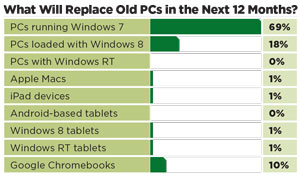 [Click on image for larger view.]
Tablets may be hot, but enterprises aren't planing to use them to replace PCs.
[Click on image for larger view.]
Tablets may be hot, but enterprises aren't planing to use them to replace PCs.
In the first quarter of this year alone, Apple delivered 19.5 million iPad devices, while Microsoft shipped a mere 900,000 Surface Pro and Surface RT devices, market researcher IDC reported last month. Counting third-party PC vendors, Windows 8 accounted for 1.6 million units and Windows RT for just 200,000. Of course, Apple isn't the only company overshadowing Microsoft in the tablet market. More than 27 million devices based on the Google Linux-based Android OS shipped in Q1 2013 -- more than Apple and Microsoft combined.
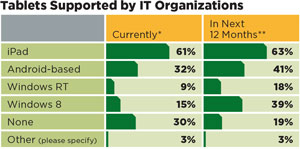 [Click on image for larger view.]
*A majority of enterprises support some tablets (notably iPad devices) yet nearly a third don't support any yet.
[Click on image for larger view.]
*A majority of enterprises support some tablets (notably iPad devices) yet nearly a third don't support any yet.
** Windows 8 and Windows RT tablets will get more love from IT, but not as much as iPad and Android-based devices.
Perhaps the most stinging rebuke of Windows 8 came in April from IDC, which patently blamed the failure of Windows 8 to catch on for the precipitous decline in PC shipments last quarter. Others have since argued it's unfair to blame the falloff in PC demand on Windows 8.
"True, Windows 8 is not a gigantic success, but part of that is because Windows 7 was such a tremendous success that people aren't compelled to move," says Patrick Emmons, director of professional services at Chicago-based Adage Technologies Inc., a development shop that has built some specialized apps to be rolled out on Windows 8 tablets.
More than half (54 percent) of Redmond readers don't have a single Windows 8 PC in their shop, according to our survey. And 37 percent said Windows 8 accounts for less than 10 percent of PCs -- presumably a handful, in most cases. Over the next year, 39 percent said they won't have any Windows 8 PCs, while in two years, more than one-quarter (26 percent) still won't have one. Only 8 percent said all of their PCs will be Windows 8-based in two years. [Due to rounding, some charts may add up to slightly more than 100 percent. -- Ed.]
Directions on Microsoft analyst Michael Cherry isn't surprised to hear those findings, but says they could change dramatically if the application ecosystem to support the Windows Store model for so-called "Metro-style" apps accelerates over that time. "Operating systems exist for applications. Until there are applications, it's just going to languish," Cherry says. "Some will buy Windows 8 because it comes on new machines, but there's no compelling reason to buy it."
Windows 7 Momentum Perseveres
When an OS comes out, it's not unusual for IT organizations to re-image new PCs with whatever version of Windows on which the organization has standardized. In keeping with that practice, that's what many intend to do with Windows 7, arguably the most successful version of the OS in Microsoft history. Over the next 12 months, 36 percent will replace all systems running Windows XP or Windows Vista. Presumably, most of those will be Windows XP-based PCs, which Microsoft has warned it will no longer support with security or system patches come 2014.
Yet when enterprises replace those PCs, 69 percent of survey respondents said they'll run Windows 7, while 18 percent will use Windows 8. Ten percent are undecided. Just 1 percent said they will replace their old PCs with Apple Macs -- and, more notably, only 1 percent said they will replace them with iPad devices. Another 1 percent said they'll replace their PCs with Windows 8 tablets, and none will do so with Windows RT tablets, a clear sign that IT shops don't see tablets as replacements for PCs, even if tablet usage makes individuals less reliant on PCs.
"I don't see the iPad replacing Windows," says Charles Palmer, a systems engineer with St. Petersburg, Fla.-based insurance company Wright Flood. "People will use desktop PCs with keyboards and mice to do their work for the foreseeable future. The iPads are used by people in the field for quick, actionable data, but if they have to do serious typing, they don't use a touchscreen -- they use a keyboard."
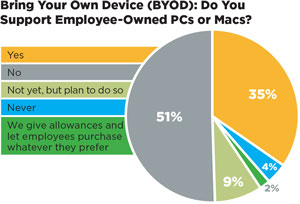 [Click on image for larger view.]
BYOD is big and growing but it hasn't caught on everywhere yet.
[Click on image for larger view.]
BYOD is big and growing but it hasn't caught on everywhere yet.
Wright Flood has just replaced 350 Windows XP systems with PCs running Windows 7. Later this year or next, another 250 employees in its New York office are due for upgrades. The problem with migrating those systems, Palmer explains, is it would cost $6 million to upgrade an application to run on Windows 7 or Windows 8 PCs. "That's not happening," Palmer says, without reservation. Whether Wright Flood moves to another system that can run on newer versions of Windows is still under discussion.
Nevertheless, Palmer says the company's not ruling out migrating to Windows 8-based PCs. "If we can get the compatibility worked out we may skip [Windows] 7 and go to [Windows] 8 from [Windows] XP," he says.
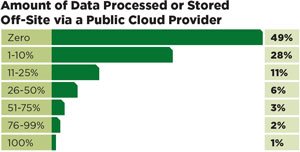 [Click on image for larger view.]
A lot of data touches the cloud in some form.
[Click on image for larger view.]
A lot of data touches the cloud in some form.
Johnsonville Sausage LLC, a food producer based in Sheboygan Falls, Wis., is in the middle of upgrading 1,000 PCs. So far it has replaced about 500 of the Windows XP machines with Dell-Wyse virtual desktop infrastructure (VDI) thin clients running Windows 7. The company is among the 6 percent of respondents who said they're using VDI or thin virtual clients.
Dan Allensworth, the company's manager of technical services, says there were a few advantages to going with a VDI implementation. "It's more secure and it's easier to apply patches in a VDI environment," Allensworth says. "It also lessens the desktop support calls."
Interestingly, going to VDI has also helped the company manage its Bring Your Own Device (BYOD) initiative, according to Allensworth. The BYOD policy in place only applies to mobile phones and tablets, not PCs, he explains. The VDI infrastructure is all VMware-based, coupled with mobile device management software from the SAP Afaria unit.
Windows 8 Will Wait
Allensworth says the company is testing Windows 8 and Windows RT tablets but has nothing kind to say about the latter. Among other things, the devices are difficult to manage because they can't be attached to an Active Directory domain. "You can't implement policies on Windows RT," he says. "Another major reason is the performance isn't there. We've had some issues with applications."
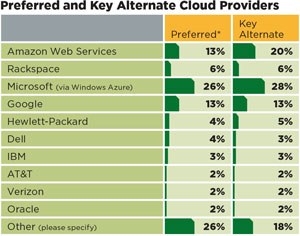 [Click on image for larger view.]
*Amazon Web Services may be the most widely used cloud provider, but Windows Azure has greater appeal to Microsoft-oriented IT pros.
[Click on image for larger view.]
*Amazon Web Services may be the most widely used cloud provider, but Windows Azure has greater appeal to Microsoft-oriented IT pros.
Despite the tests, Allensworth is candid about the prospects for widely deploying Windows 8-based systems. "To say `massive deployments of Windows 8,' I think you'd be looking at 2015 or later," he says.
How does the future bode for Windows at Johnsonville Sausage? "I think for the next 10 years, you're going to have to have Windows running," Allensworth says. "Don't get me wrong -- 90 percent of all our applications are Windows-based today, and I think that number is going to drop down every year to where it will be more mobile apps and less Windows-based apps. But I think 10 years from now, 20 percent of apps will still be on Windows. That will force us to keep running that environment."
While organizations may ultimately migrate from traditional Windows applications to modern touch apps and perhaps those controlled via voice commands, Microsoft is looking to ensure its new Windows Store app environment is where IT will go. Today 61 percent of Redmond readers support the iPad and 32 percent support Android-based tablets, yet only 15 percent support Windows 8 tablets and a mere 9 percent deal with Windows RT tablets. Over the next year, support for the iPad and Android-based tablets will increase moderately to 63 percent and 41 percent, respectively, while 39 percent will support Windows 8 tablets and 18 percent will administer those based on Windows RT. Nineteen percent won't support any tablets, down from 30 percent today.
For many, Windows 8 remains a tough call. Joy Robbins, technology coordinator for the Waverly South Shore School in Waverly, S.D., ordered 60 tablet PCs. Robbins runs a self-described Microsoft shop having just upgraded its Windows Server 2003 infrastructure to Windows Server 2012, and her order was for tablet PCs running Windows 7, which isn't optimized for touch.
 [Click on image for larger view.]
The subscription model is taking hold.
[Click on image for larger view.]
The subscription model is taking hold.
"As the technology coordinator, I just don't feel the staff is ready to go to Windows 8," she says. "I've talked to a lot of technology coordinators around the state and they're not ready to go with Windows 8, either."
What will make them ready? "We need to get more training for them," she says, noting that would have to occur over the summer in the case of K-12 teachers.
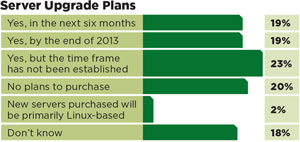 [Click on image for larger view.]
The server business may be slowing, but many still have upgrades planned.
[Click on image for larger view.]
The server business may be slowing, but many still have upgrades planned.
Wait and See
Gartner Inc. analyst John Rizzuto is hardly surprised at the slow uptake for Windows 8. "We haven't expected Windows 8 to really be an enterprise solution, and many customers need to focus on getting their Windows 7 migrations complete," Rizzuto says.
But Rizzuto is steadfast in his belief that the current tablet landscape trends don't necessarily portend doom for Microsoft or the new generation of Windows as some have predicted -- though he's not ready to declare victory for Redmond, either.
"Basically, the market and the world are in a wait-and-see mode, and it can go either way," Rizzuto says.
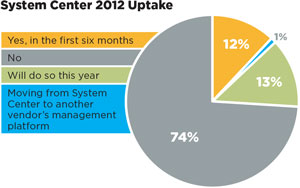 [Click on image for larger view.]
A small percentage have deployed the latest version of the newest Microsoft systems-management platform.
[Click on image for larger view.]
A small percentage have deployed the latest version of the newest Microsoft systems-management platform.
Upgrade plans: The vast majority is sticking with older versions.
The continuous deployment model that Microsoft has shifted to with Office 365, where updates are rolled out on a much more frequent basis than the old three-year release cycle, is manifesting itself with Windows as well. The first evidence of that will come to light this month at the BUILD conference in San Francisco, when Microsoft rolls out
Windows "Blue," the code name for the next wave of the OS. Windows Blue is expected to include interface updates and support for smaller form-factor devices.
But for the stars to align for Microsoft and Windows 8, Rizzuto says the OEM and developer communities need to ramp up and mature their own offerings. Moreover, the Microsoft app store -- the Windows Store -- still has a limited number of apps, and so far enterprises have shown little interest. Of those surveyed, 63 percent had no plans to use applications based on the Windows Store model, and 31 percent said they plan to deploy less than one-quarter of such apps. Even when it comes to using enterprise app stores or portals, more than half (55 percent) of Redmond readers had no plans to use them.
Developers, Developers, Developers
That can change, of course, if ISVs and developers build compelling Windows Store apps, Rizzuto says. "The application developers have to learn how to develop and build for Windows 8. Microsoft itself needs to learn how people are using it, how developers want to use it, and adjust accordingly," he explains. "Those things still need to really mature and come out, and it also means that a lot of these numbers, when you start looking one to two to three years in the future, can change dramatically."
Adage's Emmons, whose custom development shop builds apps for iOS and Windows, is among those who believes knowledge workers and professionals will gravitate to the next generation of Windows because the need for PC functionality won't go away -- even in a tablet world.
"It's true the iPad is at the forefront and there are a lot of solid reasons to pick the iPad, but we think Windows 8 is a better option for a lot of businesses," he says. "With a corporate environment, you have people at desktops as well as in the field. One of the challenges is supporting multiple versions of the same app on different types of systems. That's a real cost if you build on the Mac, iOS or Android."
From a development perspective, Microsoft has helped those who build apps using its Visual Studio tooling to transition from building ASP.NET apps to the current XAML environment, Emmons says. "The transition to Windows 8 development is not that rigorous," he says. "Microsoft focused on making things fast and fluid."
Despite the buzz over BYOD, half of all organizations surveyed still don't support employee-owned PCs or Macs, though only 9 percent said they never will. Only 2 percent take the progressive stance of giving employees an allowance and letting them procure whatever they choose.
IaaS Cloud Challenge
BYOD is changing the way client devices are managed in IT shops these days. And the rapid proliferation and usage of cloud computing services is impacting how datacenter resources are procured, paid for, provisioned and managed.
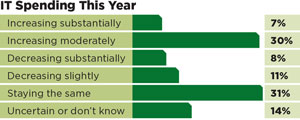 [Click on image for larger view.]
IT spending is all over the map.
[Click on image for larger view.]
IT spending is all over the map.
 [Click on image for larger view.]
The jury is still out.
[Click on image for larger view.]
The jury is still out.
Three years after launching Windows Azure as a complete Platform as a Service (PaaS), Microsoft is finally able to let customers stand up their own VMs in the company's cloud. That means, for the first time, the Windows Azure Infrastructure as a Service (IaaS) is now a viable alternative to the widely used Amazon EC2.
Thanks to cut-rate pricing and a widely distributed global cloud service, some of the largest cloud implementations run on Amazon EC2, including Netflix, NASDAQ OMX and Dropbox. Yet, surprisingly, Windows Azure may be more widely used than it appears.
Twenty-six percent of Redmond readers use Windows Azure, while an equal percentage use "other" services not mentioned in our survey (such as those from Rackspace US Inc., AT&T, Verizon, Google, Hewlett-Packard Co., Dell Inc., IBM Corp. and Oracle). That suggests many are using regional hosting providers or nothing at all. As for Amazon, 13 percent of respondents indicate they're using EC2. However, the number that plan to use Amazon over the next 12 months jumps to 20 percent, while the number that plan to use Windows Azure increases to 28 percent. Those using other services will drop to 18 percent.
Morgan Stanley's April CIO Survey showed similar preference for Windows Azure, where 20 percent use it for PaaS functionality compared with 12 percent who use Amazon (though it should be noted that Amazon is primarily an IaaS provider). The Morgan Stanley CIO Survey showed 13 percent are using Windows Azure IaaS -- presumably the preview release, as the survey was conducted before the April 16 launch of Windows Azure Infrastructure Services. As a result of the strong interest in Windows Azure from CIOs, Morgan Stanley is bullish on Microsoft's cloud prospects.
 [Click on image for larger view.]
Redmond's future looks promising.
[Click on image for larger view.]
Redmond's future looks promising.
"Our research suggests Microsoft's large technology base and captive audience of [more than] 5 million .NET developers has propelled the company into an early leadership position in cloud platforms," wrote Keith Weiss and Melissa Gorham in the April research note. "Additionally, the cloud-based Office 365 platform continues to see good adoption in customers of all sizes."
The Morgan Stanley analysts warned that the contribution from these cloud initiatives remains relatively small today, "and the shift to subscription licensing may actually create slight near-term headwinds. However, the potential positive-sentiment impact of Microsoft being seen as a `winner' in the cloud as these offerings gain scale and exposure could act as a positive catalyst for Microsoft shares, in our view," they wrote.
More than half (51 percent) of data is either processed or stored by public cloud providers, according to the Redmond readership survey. Only 1 percent process or store all of their data in the cloud.
Forrester Research Inc. analyst James Staten believes Microsoft stands to gain further credibility as a cloud infrastructure provider with its new IaaS release. "Microsoft Windows Azure IaaS will feel familiar to developers who have experience with Amazon Web Services Elastic Compute Cloud," Staten noted in a blog post.
Microsoft System Center admins will also find the service familiar and very much like a Hyper-V compute pool, he added. "This is probably the best validation of the hybrid cloud model from a major tech supplier so far this year," Staten said.
Yet only 12 percent have upgraded to System Center 2012, while 13 percent plan to do so this year. A mere 1 percent plan to move from System Center to another management platform. The appeal of System Center 2012, Rizzuto adds, is the ability to burst workloads between a Windows Server-based infrastructure in the datacenter to the same infrastructure in the public cloud. "[Microsoft] moved fairly aggressively once they decided that the cloud was the future," Rizzuto says.
Period of Transition
Microsoft is very much in a mode of transition, both from an end-user and datacenter perspective. Over the past 12 to 18 months, the company has released substantial upgrades to just about everything it offers, while gradually transitioning to a continuous-deployment model of upgrades.
So how do Redmond readers feel about Microsoft's recent and planned wave of offerings for enterprises? While only 16 percent said they were impressed, a smaller 8 percent said they were disappointed. The remaining 76 percent are still evaluating. In other words, IT pros are very much waiting for this story to play out, which by all accounts will take many years.